 Our trip to the Sanchi Stupa was a memorable trip and will always remain so. It felt wonderful going round the place, knowing about it and experiencing its beauty. We went there by a bus (M.P. Tourism). After passing the security gate, our eyes met the sight which we all had eagerly awaited for- The SanchiStupa. It appeared to be really beautiful. Our guide was very friendly as he told us about the place in a descriptive manner and patiently clarified each of our doubts. Sanchi Stupa has four gates in all four directions. The hate on the west direction is the main entrance but we entered through the Northern gate.
Our trip to the Sanchi Stupa was a memorable trip and will always remain so. It felt wonderful going round the place, knowing about it and experiencing its beauty. We went there by a bus (M.P. Tourism). After passing the security gate, our eyes met the sight which we all had eagerly awaited for- The SanchiStupa. It appeared to be really beautiful. Our guide was very friendly as he told us about the place in a descriptive manner and patiently clarified each of our doubts. Sanchi Stupa has four gates in all four directions. The hate on the west direction is the main entrance but we entered through the Northern gate.
The guide told us that a Stupa is a dome made to keep the remnants of a person (asthiyaan). The remnants of Gautum Buddha are kept in the Sanchi Stupa. The materials used for building the Stupa are a mixture ofurad dal, moong dal, masoor, methi(fenugreek) juice, a tree’s bark, gud(jaggery) and the fruit bel’s gum. It is said that after Gautum Buddha died in Kushinagar, his ashes were divided into eight parts and kept in eight domes. King Ashoka, after the Kalinga war, opened seven of the domes and made eighty four thousand domes made of lord Buddha’s ashes and the first Stupa was made in Sanchi. Vidisha, a place 9 km away fromSanchi, is named after Ashoka’s second wife, Vidisha. In 2nd BC, a ruler of Songo Dynasty covered theStupa to prevent its damage due to rainwater. Greek architecture can be found in the Stupa as it has Greek columns. Carvings on one of the gates of the Stupa showed monkeys collecting and presenting honey to Buddha so that he may remain healthy.
The guide briefed us about the early childhood stage of Gautum Buddha. Mahamaya, Buddha’s mother, dreamt that a white elephant entered her stomach which took birth. As the birth of Siddhartha (as Buddha was earlier called), a priest predicted that he might either become a great ruler or a saint. In the fear that he may become a saint, he was never allowed to go out of the palace. He was married at the age of nineteen and had a son named Rahula. At the age of thirty, he was allowed to stroll outside the palace for the first time. He saw four incidents on the way-a dead man’s funeral, a weak man starving for food, an old man and a saint. These incidents highly affected him and he decided to go the forest for meditation. His horse, Kanta, on which he set out to leave, was carried by his followers so its footsteps would not be heard. He reached the forest, performed meditations, and preached people about good things.
The Sanchi Stupa was discovered by Mark Taylor. John Marshall repaired the southern and eastern gates of the Stupa.
Article by Aditi Gupta of class 7-C Study Hall School
 DONATE
DONATE


 Volunteer
Volunteer
 Work With Us
Work With Us
